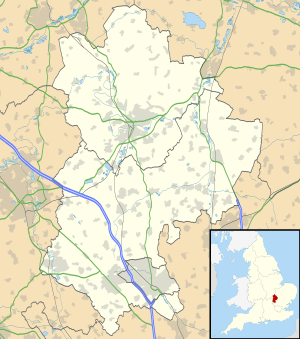Great Barford Castle facts for kids
Quick facts for kids Great Barford Castle |
|
|---|---|
| Great Barford, Bedfordshire, England | |
| Coordinates | 52°09′53″N 0°23′07″W / 52.16466°N 0.38515°W |
| Type | Castle |
| Site information | |
| Condition | Earthworks |
Great Barford Castle was an old Norman castle in the village of Great Barford, Bedfordshire, England. It was later known as "Creakers Manor."
This castle was a type called a motte and bailey castle. This means it had a large earth mound (the motte) with a tower on top, and a walled courtyard (the bailey) below. It was built from timber and surrounded by a moat filled with water.
Great Barford Castle was named after its location, just north of the Great Barford area. It was also close to other castles. For example, it was about 1 mile south of Renhold Castle. Because of this, some people called it the "Second Renhold." It was also near Bedford Castle, which was 5 miles away, and Gannock Castle, 6 miles to the east.
Building a Castle: Early Days
People first thought Great Barford Castle was built right after the Norman Invasion in 1066. This was when William the Conqueror became King of England and ordered many castles to be built for defense.
However, we now know it was built a bit later, after the Domesday Book was finished in 1086. By the year 1250, the castle was standing. It was owned by a family called the Crevequeors. James de Crevequeor (who died in 1263) was one of the first owners. The castle later got its name "Creakers Manor" from this family.
Over the years, the castle stayed with the Crevequeor family. In 1302 or 1303, James de Crevequeor, a younger son, owned it. By 1416, Stephen de Crevequeor and his wife Anne were in charge. They still held it in 1530.
Later, John de Crevequeor (who died in 1370) owned it around 1346. When he died without children, his nephew Stephen inherited it. This Stephen also died young, so his younger brother, John Crevequer, took over in 1385. This is when the castle was first officially called "Creaker's Manor" in old documents.
What Happened Next: Later History
The manor isn't mentioned again in records until 1511. At that time, William FitzJeffrey of Thurleigh owned it. When he died, it passed to his son, John FitzJeffrey.
John FitzJeffrey died in 1535. His wife, Joan, kept the property for a year. Then, it went to John's half-brother, George FitzJeffrey. When George died in 1575, he left the manor to his second wife, Judith Throckmorton. She was from the famous Throckmorton family.
Judith later married John Rolt. In 1589, Judith and John gave the manor to George's son, also named George FitzJeffrey. This George was made a knight in 1606. He died in 1618 without any children who could inherit it. He was buried on the property.
After this, the property was sold many times. It was owned by the Chandler, Mander, Peck, and Halsey families. Finally, in 1770, it was sold to the Pedley family.
It's thought that the manor mentioned after 1511 was not the original castle from the 11th or 12th century. The original castle might have been destroyed or fallen apart. Its remains were probably used to build the later manor house. But we don't know for sure what happened.
Great Barford Castle Today
By 1820, the manor house no longer existed as a manor. A priory (a type of religious building) had been built where the castle once stood.
Today, very little is left of the original Great Barford Castle. You can only see faint cropmarks (patterns in crops that show old structures) and slight earthworks (changes in the ground from old buildings). These small clues are all that remain of the old Norman castle.


